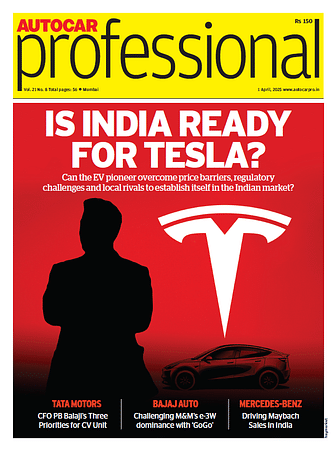‘I want Aston Martin to stand on equal terms with Porsche, Ferrari and Bentley.’
Aston Martin’s CEO Andrew Palmer speaks to Sumantra B Barooah about how he plans to take the brand to the iconic heights of Ferrari and Porsche, and the role India can play in Aston Martin’s overall scheme of things.
Aston Martin’s CEO Andrew Palmer speaks to Sumantra B Barooah about a varied range of topics — from the key challenges in his barely four-month-old role, to how he plans to take the brand to the iconic heights of Ferrari and Porsche, and the role India can play in Aston Martin’s overall scheme of things.
In your new role, what are the top three things you would like to do?
There is huge pressure and responsibility in taking over such a great brand. I have arrived in a business that’s in good shape, but I have key goals in mind which I am already engaged in delivering.
In the short term, we need to continue to build on the asset of the brand – especially in geographical regions where heritage is not quite so well recognised. These also happen to be the areas where the luxury market is developing most and where some of the high net-worth people reside. India, of course, is one example of these rapidly growing markets.
In the longer term, my intention is that we turn Aston Martin from a great British company to THE great British company that can stand on equal terms with Porsche, Ferrari and Bentley but with a very different reason for existence. That difference lies in our DNA, which is the embodiment of Power Beauty Soul and which allows us to stand apart in that venerable company.
From a product perspective, we have a great portfolio to work with, but my background is in product creation. In my first month I have already looked at how we can utilise our great people and great brand to make even more amazing cars in the future.
Aston Martin has had a mixed financial history. What are the steps that the company plans to take, or has taken, to ensure a sustainable healthy business?
Aston Martin has been around for 101 years. We have a wonderful history of beautiful sports cars. However, we can’t ignore the fact that, in that history, there have been periods of feast and famine which have been dependent on the frequency of cars being launched and the financial health of the owners at the time. To put that into context, we currently sell approximately 4,000 cars per year – but in our total history we have sold less than 80,000. What is wonderful about that statistic is that 90 percent of those 80,000 cars still exist today. We now have to transpose that lineage into a long-term and stable business plan. This means that we need to invest heavily in a portfolio that is relevant to our current generation of owners and potential owners and, indeed, bring the magic of the Aston Martin brand and make that relevant to a new generation of people living in countries and regions that are not as familiar with the brand as in the UK. Needless to say, long-term stability comes with launching a new portfolio of cars and an expenditure of more than £500 million (Rs 4,835 crore) to execute this.
Aston Martin has had a subdued presence in India so far. Last year around 10 cars were sold in India. What role do you see for India in Aston Martin’s overall scheme of things in the coming years?
India obviously has great potential, and in fact a great many Indian people already own Aston Martins – although today they do not necessarily drive those cars in India.
The challenge is that, by nature, we are an exclusive luxury brand and, essentially, we make our cars on a one-off basis, bespoke to each customer using craftspeople at our manufacturing base in the UK.
That business model doesn’t lend itself to the traditional way of selling cars in India, where there are extremely high taxes for imported sports cars. So today we concentrate on high net worth individuals inside and outside of India but I would like, at some point, for the Indian government to recognise the special nature of luxury cars and to consider a less punitive tax structure that would allow more Indian people to enjoy the magic of Aston Martin.
Are you satisfied with Aston Martin’s current performance in India? How do you plan to tap the growing luxury/performance car market in India?
One can never be satisfied. So, of course, we look continuously for ways to improve. But the way of improving may not follow the same thought process that you would use for a mass or premium brand. Again, Aston Martin is all about the kind of luxury that you dream about. That means that it is not about the volume of cars that we sell, but more about the exclusivity of the brand.
From that point of view I’d like to see the familiarity of Aston Martin amongst the people of India rise dramatically, such that the brand is one of the most desired in India. Yet, on the other hand, I would still want to keep the volume aspirations at a modest level in order to create that sense of exclusivity, self-reward and self-fulfilment for people who eventually own the brand.
Around 15 percent of Aston Martin’s sales comes from Asia. Is there a focus on growing the presence in Asia? If yes, how much sales do you expect from Asia by 2020?
Certainly we are putting a lot of emphasis on Asia. We are currently in the process of establishing regional offices in Japan and Singapore to complement those that we have already in Shanghai and Dubai. Clearly, Asia and Oceania represent areas of growth for us – simply because of the growth of the economy in these regions and the emergence of high net worth individuals that aspire to the brand.
So in managing and developing the new products, where each new product has a representative customer to help us define the product, perhaps for the first time, you will see cars targeted at both Asian and female potential customers.
Does Aston Martin plan to enter the premium compact car segment (like the A-class, 1-Series)?
Never on my watch! This is a high luxury sports car company. As such, concentrating on our core business in the sports car sector – with the valuable addition of the new Lagonda super saloon – is the foundation of our product strategy.
By when can we see the first product from the Aston Martin-Daimler partnership for sourcing engines?
The relationship with Daimler is important and deep, because it allows us access to engines and technologies from one of the greatest premium manufacturers in the world and those technologies are such that we would never be able to develop in their entirety by ourselves.
That said, those technologies create only a part of the platform for what Aston Martin will create in the future. They are an enabler, but they do not detract from the creation of pure-bred Aston Martin cars that are the embodiment of Power Beauty Soul. To tell you when some of those technologies will hit the streets would be the same as telling you what is in your Christmas, or Diwali, present – so I will duck that question for now!
I understand that Aston Martin has at least one Indian supplier of rubber parts for the exhaust system. Are there any more? Does Aston Martin plan to tap the Indian supplier base further?
Aston Martin sources the very best components from the very best suppliers around the world. But it is not just a question of tapping into India for suppliers but also for the intellect that is available. We have many people in our teams here in the UK who are playing a key part in developing our new products.
When can we expect the next model from Aston Martin? Is the company planning to have a more affordable model in its range? If yes, by when?
We are updating our range of sports cars continuously, but if you want to focus on new models I draw your attention to the Lagonda Taraf we launched in Dubai last month. That gives you a sneak peek into the current thinking of the corporation – expanding into new markets in ways that are not necessarily traditional to us.
Among all luxury/performance carmakers, Aston Martin is the only one which is not part of a large corporation. Is that proving to be a challenge for the company, or does it have certain significant advantage/s?
Well, if Aston Martin was part of a greater corporation, I wouldn’t be the CEO!
What attracted me to Aston Martin is, indeed, that independence and the ability to create something that no other manufacturer can create: exclusivity which is quintessentially British but relevant on a global stage. By ‘quintessentially’, I mean something that is a statement of everything the brand stands for – not only in the past with cars like DB5 and the James Bond movies but also a luxury product that’s relevant to modern-day entrepreneurs in places as diverse as London, Shanghai, Tokyo and Delhi.
Obviously being independent is a challenge in terms of access to huge R&D budgets and technology that is affordable only by the ability to sell cars in the millions. The relationship with Daimler allows us the best of both worlds: we are able to maintain our independence, our agility and our passion and we are able to maintain our desire to craft beautiful sports cars, but we also have a partnership which allows us access to the world’s best technology.
RELATED ARTICLES
'India Can Become a Major Pillar for Us' - Marquardt Group
Björn Twiehaus, CEO of Marquardt Group, and Vishal Narvekar, the company's India GM, share their outlook on the Indian m...
Luxury Car Market to Slow in 2025: Mercedes-Benz Sees Flattish Numbers
In Jan to March of 2025, the market may witness its slowest growth since COVID-19, and if the weakness continues, the se...
‘We Must Have More Women Leaders in the Auto Sector:’ Anjali Rattan
The chairperson of the New Delhi-headquartered RattanIndia Enterprises believes that with their multi-tasking nature, wo...






 05 Jan 2015
05 Jan 2015
 4859 Views
4859 Views





 Darshan Nakhwa
Darshan Nakhwa


 Prerna Lidhoo
Prerna Lidhoo


